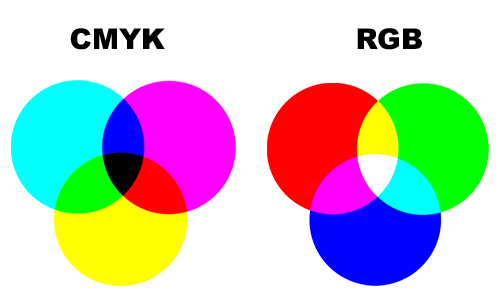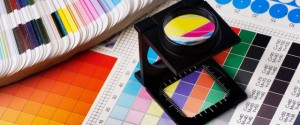The Difference Between RGB and CMYK Colors in Digital and Print Design
November 3, 2015
If you’re designing or printing anything in color, then you’ve likely heard of the two most common color formats, RGB and CMYK, at one time or another. The main difference between these two formats is that RGB is usually used for any type of digital work while CMYK remains the standard for things that are being printed.
No matter what you’re using these color formats for, it’s important to understand how RGB and CMYK colors work from a design standpoint, and how they might add, or take away from your current project. Now, keep in mind that neither one of these color formats are perfect and, in fact, neither one can accurately produce all of the colors found in nature, but let’s take a closer look at the characteristics and different uses of RGB and CMYK colors.
Creating RGB and CMYK Colors for Design

Photo provided by designtaxi.com
Like you’ve probably guessed by now, RGB is an abbreviation for the three primary colors of red, green, and blue. The combination of these three colors in different formats can be used to create a wide variety of shading and colors. Known as an “additive” color model, RGB is typically used in digital design and the three colors are added together to form a digital picture, which is why if you look very closely at your computer or television screen you can sometimes (not always) make out the tiny pixels that create the picture. The larger the screen is, the easier this is to see. The ways that these three colors can produce hundreds of different design combinations is by projecting light through these pixels, and blending the colors on the retina of your eye to create the colors desired. Essentially, it tricks your eyes into seeing colors that aren’t really there.
CMYK is an abbreviation for cyan, magenta, yellow, and black, and these four colors are used quite a bit in printing. The process by which these four colors create hundreds of different shades and colors is a bit more complicated than that of RGB. As we mentioned above, RGB is considered an “additive” process that’s used to create colors. Well, CMYK is exactly the opposite: colors from the natural light spectrum are subtracted to create different pigments and dyes for printing. These are then printed onto a surface in thousands of tiny dots made from cyan, magenta, yellow and black colors. The dots are spaced methodically to create the appearance of different colors and shading.
Designing with RGB and CMYK Colors
Photo provided by Wikipedia.org
Like we said earlier, RGB and CMYK colors have very different uses, and RGB is used primarily for digital design, such as television, computers, and certain forms of photography. Each device may interpret RGB value differently, which is why many designers create their digital designs with their intended medium in mind. For digital work, especially if you’re using a computer for your design work, it’s usually best to use RGB colors. Using RGB will show you the most accurate color portrayal of your finished product.
Using RGB and CMYK colors for both digital and print

Photo provided by Wikipedia.org
Although RGB is intended for digital mediums, many designers prefer working with RGB for all projects, then later converting print projects to CMYK after the design process is finished. This has several benefits, the first being that RGB has a much wider range of color options. Your files will most likely be converted to CMYK at some point during the process.
However, there are added benefits to using RGB during the design process, such as it allows for much smaller files sizes so your RGB designs will take up less space. Additionally, most design programs such as Adobe InDesign, Photoshop, or Illustrator, rely on the RGB format. Working with RGB can also be beneficial if you’re designing images that will be both printed, and used on the web, as they’ll be “web ready” and won’t need any type of file conversion to appear online.
If you know beforehand that your designs will only be appearing on a printed surface, then you have the choice of either designing it in CMYK, or creating your design in RGB and then converting the file before sending it to the printer. Designing in the CMYK color mode will help you get a clearer representation of you finished product; you don’t want to spend hours designing something that looks great on your computer screen, but falls flat when printed. We’ll talk a bit more about why this occurs in the next section.
How RGB and CMYK Colors Are Rendered Differently

Photo provided by pinterest.com
Based on the amount of white space being used, and how much blending occurs in the colors you’ve used for your design, RGB and CMYK colors are rendered differently. For example, most printed colors will always look a little darker than they do on your computer screen during the design process, regardless of whether you’re using RGB or CMYK colors.
Before undertaking any design project that may involve printing, it’s always best to consult with the print shop to see what formats they’re capable of printing in, and any details regarding file conversions. There are a wide variety of printers out there, and each one is different, so the format or dpi that one print shop requires will likely be specific to the printers that they use. If you’re interested in learning more about preparing RGB and CMYK colors for print, check out this in-depth guide.
Whether you’re working with RGB or CMYK, the experts at PrintPrint will work with you to find the perfect color and printing formats for your project. They specialize in large scale printing, full color offset printing, digital printing, and more.


